Have you ever tried to explain TikTok to your grandpa? Or better yet, have you tried to explain 8-tracks to a room full of teenagers? You can only imagine how important it is to consider your audience in these scenarios and how you tailor the message.
This guiding principle also applies to PR for SaaS companies. In fact, it’s even more important for these brands because SaaS companies have a whole lineup of audiences in the buying committee, from users and influencers to decision-makers and budget holders.
Strategic PR coverage can — and should — be used in SaaS sales to speak to all audiences, addressing different pain points for each and taking a different approach based on where they are in the purchase stage.
Users
Users — including prospects who would directly use your product and existing customers — want to be educated about tactical execution to improve their jobs. This could come in the form of best practices, customer stories or new techniques. Trade media is the best avenue for this content. Not only will this type of content help target buyers do better work, but it also helps SaaS companies demonstrate tactical expertise in target verticals.
Trade coverage is also a killer resource for SaaS sales reps to use in touchpoints with prospects. This type of coverage, especially a case study with ROI metrics, can show prospective customers exactly how a solution can be harnessed for optimal performance, pushing them further into the sales cycle.
Influencers
Influencers in the SaaS sales process are those who affect the purchase yet aren’t the platform’s end-users or the budget holder. For example, let’s say you’re trying to implement a CDP. You’ll definitely need buy-in from the IT department. If you’re implementing a GRC platform for GDPR compliance, you’ll need buy-in from the marketing department.
It’s vital for these tangential buyers to have some sort of content dedicated to them so they feel incorporated in the decision-making process. One way to do this is to tell your company’s story in trade media that speaks directly to their role (think: marketing, IT, compliance media) to meet them where they are. This way, they have more information about how a potential solution may work for them, too.
Decision-makers
Most decision-makers aren’t in the weeds of the product like the end-users themselves (though there are occasional exceptions). They need to know the value a solution could deliver to the organization and bottom line — and brand notoriety won’t hurt either. There are a couple of ways this can manifest in media coverage.
The first way is through customer stories. I mentioned this previously in the section about users, but customer stories can prove just as impactful in convincing other decision-makers about how game-changing your solution could be for their business. Take this example of Stork Club’s work with Fors Marsh, featured in Inc. Because the article is in a top-tier business publication, it pulls a broader audience than if it appeared in, say, HR Magazine. This builds the brand’s credibility outside of trade verticals, legitimizing it to various departments that care more about its broader business impact.
Another way to illuminate your brand to decision-makers is through top-tier coverage that focuses on topics outside of the product. This coverage builds the brand’s (and its leaders’) credibility on a deeper level, outside of just features and functionality. Perhaps you’ve heard of the company Authenticx, but you don’t know exactly what it does. Because you’ve heard of Authenticx, though, you might be more inclined to pay for their solution over a competitor, simply because of brand recognition. Coverage contributing to this can span a wide range of topics, including leadership, commentary about the job market and more.
As you can see, media coverage should be leveraged to reach multiple audiences in the SaaS sales process. If you’d like more information about how to help your organization do this through strategic PR, contact Lindsey Groepper.



